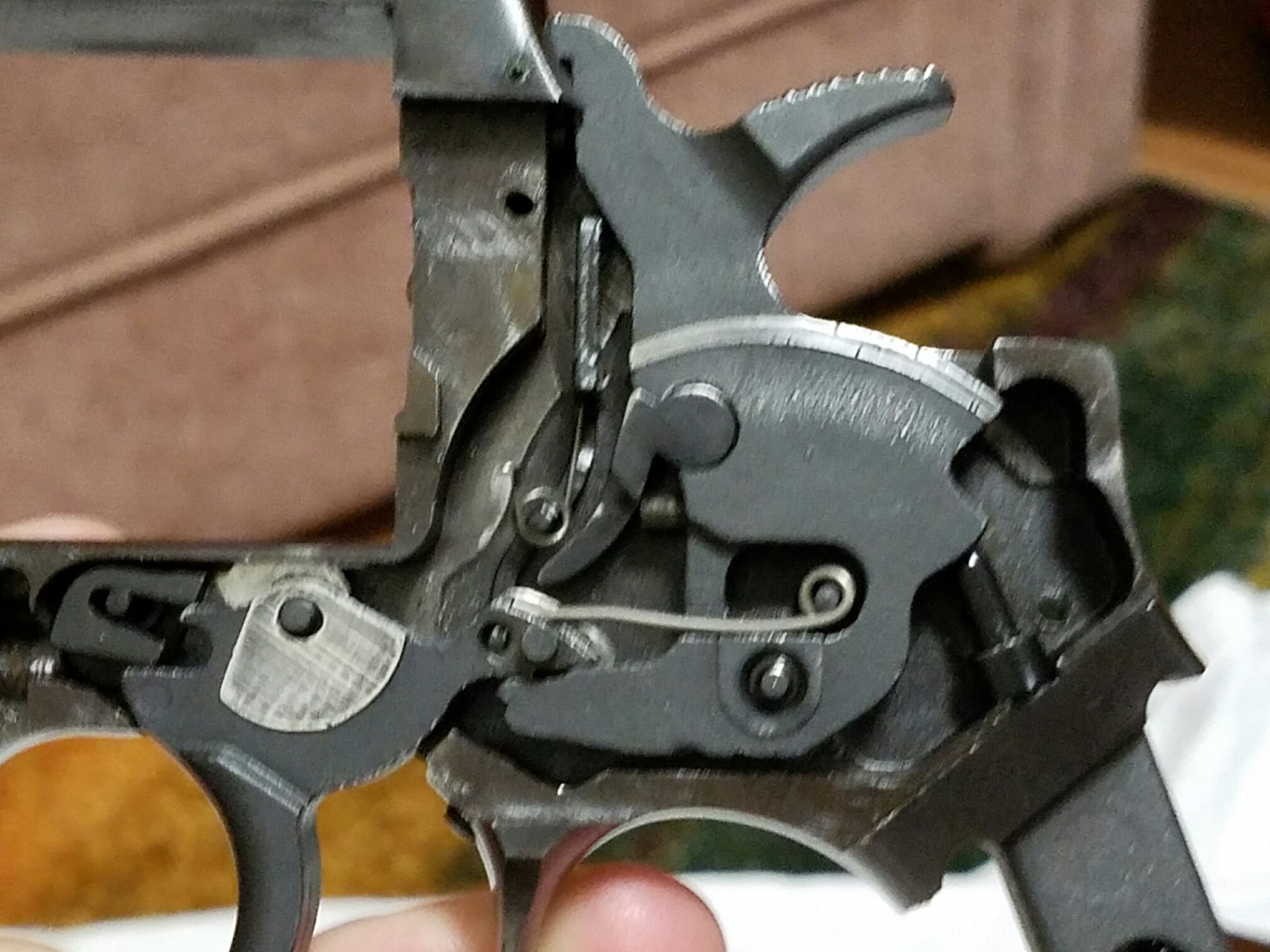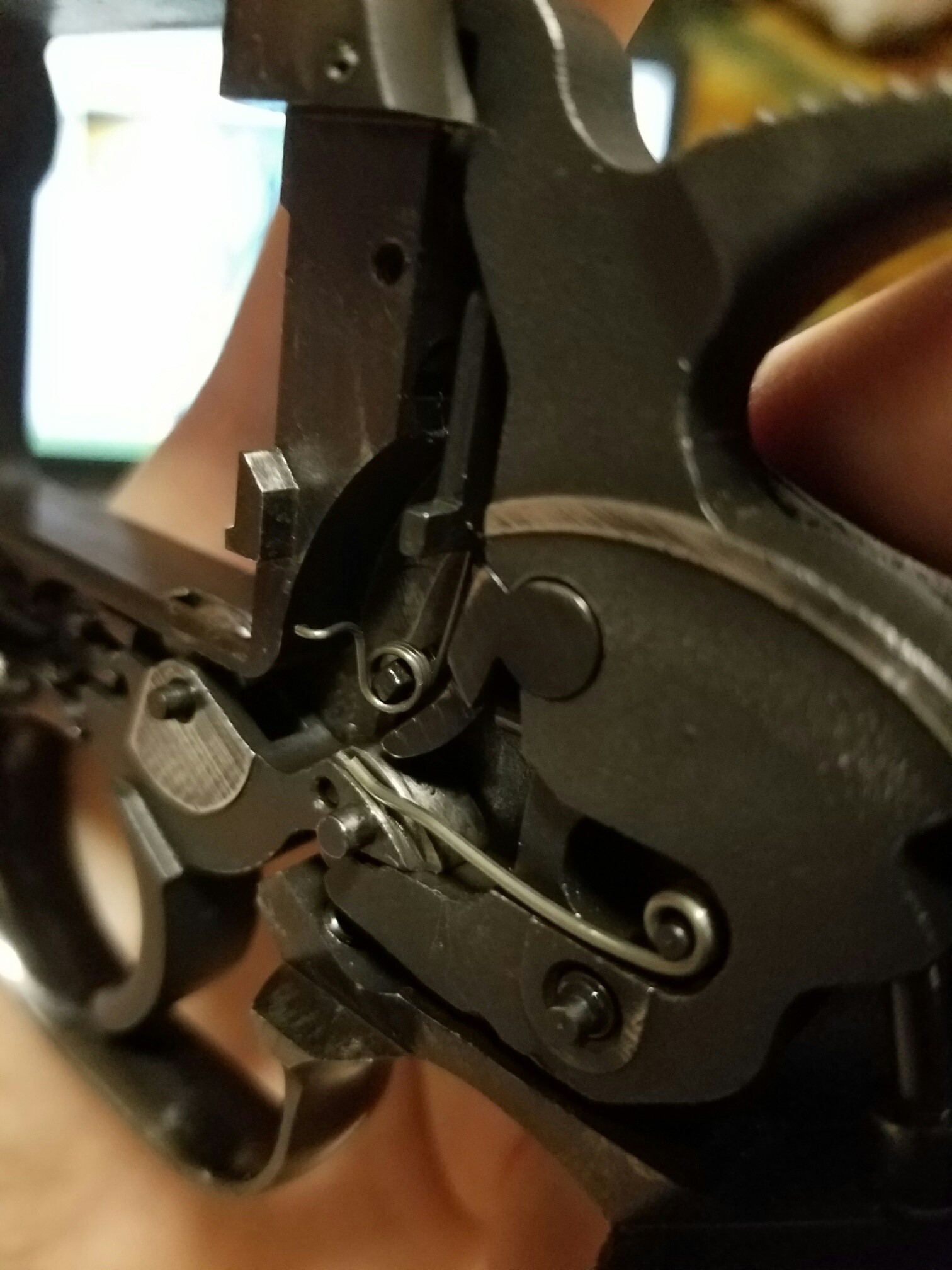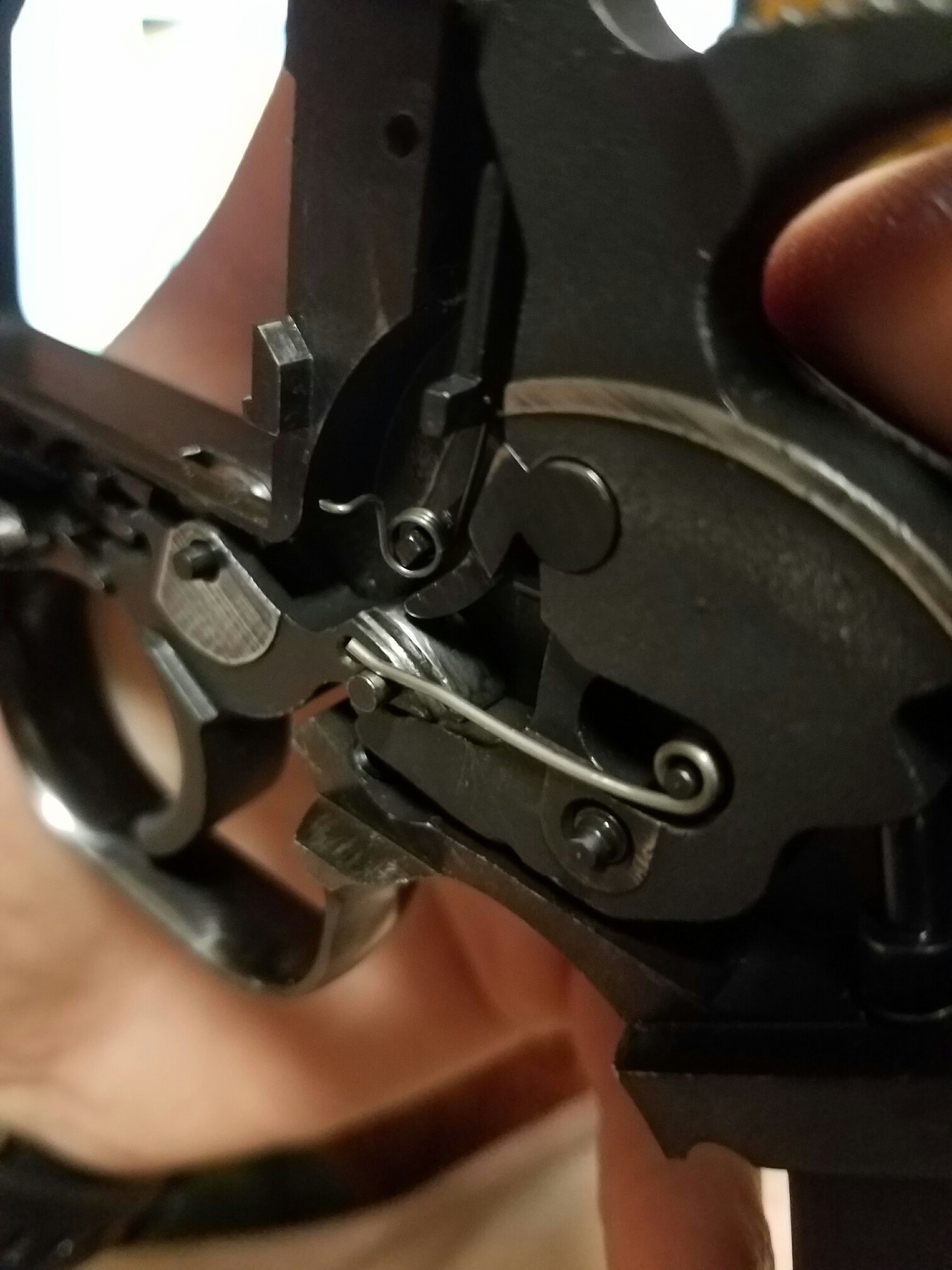Supporter
Range Officer

Range Officers
May 2, 2009
 Offline
OfflineFebruary 4, 2016
 Offline
OfflineYeah it is tough to get everything to stay put. Hopefully the pics will work this time, but I think the ledge is fairly square. I'll try drying up some of the lube when I get a chance to see if it helps. Can't help but notice that if you compare the two springs that the new one is more wide open. They are wolff springs BTW. 





Supporter
Range Officer

Range Officers
May 2, 2009
 Offline
OfflineI think you are holding your upper lip wrong when trying to replace the sideplate. Nah, just takes a little practice. You will notice a big difference in the Wolff return spring. Check and see if the frame posts are fully pressed in. Sometimes strange things can happen if they are not fully seated.
February 4, 2016
 Offline
OfflineThanks for the advice. I'll check the frame posts and keep playing with the side plate. It is very hard to find the right spot but when you do it snaps right in. I previously replaced the hammer return spring with I think an 8 LB wolff spring but also have the 7.5 LB spring. Has anyone had experience with light primer strikes at 7.5 LB?
September 16, 2015
 Offline
OfflineMarch 17, 2019
 Offline
OfflineI bought a 1979 2 1/2" Model 15-2 just like Shoot's last Saturday, joined the forum on Sunday, introduced myself, described the problems I was having with the old 15-2 and immediately Ole Dog pointed me here. This evening I finished my Average Joe Tune-Up, and enjoyed it. What a truly simple mechanism!
It had a great trigger before I messed with it... now it's even better.
I still have one issue in this old gun. Before I worked on it, if you pinched the cylinder with slight pressure while dry firing, it would come to one chamber where the cylinder stopped and the action proceeded. It does that far less often now, but it does occasionally happen. It's just as if there were no little spring on the back of the hand. It could be that the little spring on the back of the hand is weak. It could also be that there is wear on the hand or the wheel that the hand engages on the rear of the cylinder.
When I fired this pistol on Saturday, it shaved a little smile of lead on one cylinder, which dropped into the mechanism and jammed it. I'll shoot it again soon and see if that was caused by the gunk that filled the inside before I cleaned it up.
Measured the cylinder gap at 0.006". What's it supposed to be?
- MacEntyre
"We must, indeed, all hang together or, most assuredly, we shall all hang separately." - Ben Franklin
"Politics is the entertainment branch of industry." - Frank Zappa
Supporter

Moderators

Dans Club
February 22, 2009
 Offline
OfflineMarch 17, 2019
 Offline
OfflineShot the Tuned Model 15 today... no failures of any kind until after 70 or so shots... cylinder would stop turning, action kept cycling. I think the spring pulling the hand forward is weak. Spring Pak is on the way, but I've forgotten if it includes that spring.
- MacEntyre
"We must, indeed, all hang together or, most assuredly, we shall all hang separately." - Ben Franklin
"Politics is the entertainment branch of industry." - Frank Zappa
Supporter

Moderators

Dans Club
February 22, 2009
 Offline
OfflineSounds more like a worn extractor and/or hand. I think what may have happened is that the heat caused the metal to expand, the face of the cylinder hung up on the back of the barrel (gap closed to zero) and the hand skipped over the grooves in the extractor. Hard to say without being there...
Technically, the glass is always full; half liquid, half air....
I think Ron, the first Ron, is correct. When you use a gap of .002 or 3 you should wipe the face of the cylinder with a rag every several cylinders full. Take the tool to the range with you to adjust the gap. That is one reason the factory specs are .006. The cylinder expands after about 50 rounds or less. The large frame guns don't do that. Replace the hand spring first too. It is like auto mechanics. Try the little things first to correct a problem. It very well could be just the cylinder rubbing on the barrel on the proudest chamber when hot.
I mentioned Karl Lewis, considered the world 2cd best gun designer after God, John Moses Browning. He designed the Colt Trooper Mark iii. He pioneered drop in parts made by MIM that did not need hand fitting. He was the first to use a coiled hammer spring instead of a leaf spring. The lockwork is extremely simple and the hammer fall was the shortest at the time. Manurhin, Korth and Smith have all copied many of his ideas. He offered the interchangable barrel to Colt but they declined. Shortly after he partnered with Dan Wesson. One reason they may have passed is the barrel cylinder gap issue. Dan Wessons are thinking man's Revolvers. You cannot just pick it up and shoot. There are very many almost pristine Dan Wessons around today because setting the gap was too complicated for most gun owners. When they encountered what you did they put them in the safe or drawer for 30 years. I commend you for tinkering and finding the problem. DWF is a great resource that did not exist until Jody started it.
August 8, 2016
 Offline
Offlinerwsem said
Sounds more like a worn extractor and/or hand. I think what may have happened is that the heat caused the metal to expand, the face of the cylinder hung up on the back of the barrel (gap closed to zero) and the hand skipped over the grooves in the extractor. Hard to say without being there...
I’ve run into this. I thought something broke then I realized it was just the cylinder contacting the back of the barrel. Took probably 50 rounds of 44 magnum for it to happen. Adjusted the cylinder gap, good to go!
January 4, 2009
 Offline
OfflineHi guys.. been a while since I've posted here.. I've got a little .22 S&W that locks the cylinder when it's had a few too many.. I clean the front of the cylinder with a couple of wipes with a rag... I would think just adjusting the gap would not be the best idea.. I suppose you could but that gap is set by DW for a reason. Love the comments.. 
January 1, 2021
 Offline
OfflineHowdy All, This is my first effort here. I had a DW 15-2 in the latter part of the 70's. It was a duty weapon I bought/traded for. Swapped a S&W Mod 66 for it. Shot it a bunch, +100,000 rounds of .38 and .357. The first post here say's almost all of what can be done to this type of revolver. Very good advice and technique. I add this 'remedy' for your consideration? Use molybdenum disulfide (dry) as a lubricant. It will really slick up the action and use it sparingly on high friction surfaces. Especially, the single and double action sears. After awhile, it will be slicker'n deer guts on a door knob. There were no aftermarket spring kits way back then, I reshaped all of mine. I stretched the hand a couple of times. Broke the grips once. The frame turned purple because I got lazy and soaked it in carb cleaner. The cylinder stop fell out, lost. I made another one out of epoxy. All in all it was/is a fine weapon. I was a 22 year old rookie when it saved my life. I still remember the serial number to this day. It was stolen from me in Jan of 1980. Never got it back. Never bought another one. Happy New Year.

Dans Club
January 17, 2015
 Offline
OfflinePudfark said
Howdy All, This is my first effort here. I had a DW 15-2 in the latter part of the 70's. It was a duty weapon I bought/traded for. Swapped a S&W Mod 66 for it. Shot it a bunch, +100,000 rounds of .38 and .357. The first post here say's almost all of what can be done to this type of revolver. Very good advice and technique. I add this 'remedy' for your consideration? Use molybdenum disulfide (dry) as a lubricant. It will really slick up the action and use it sparingly on high friction surfaces. Especially, the single and double action sears. After awhile, it will be slicker'n deer guts on a door knob. There were no aftermarket spring kits way back then, I reshaped all of mine. I stretched the hand a couple of times. Broke the grips once. The frame turned purple because I got lazy and soaked it in carb cleaner. The cylinder stop fell out, lost. I made another one out of epoxy. All in all it was/is a fine weapon. I was a 22 year old rookie when it saved my life. I still remember the serial number to this day. It was stolen from me in Jan of 1980. Never got it back. Never bought another one. Happy New Year.
I read into it and ordered some molybdenum disulfide. I have also been wanting to use some of this on my Harley locks. How sparingly do you apply it on your revolvers?
January 1, 2021
 Offline
OfflineWay back in the day, I shot that revolver a lot. It was not uncommon for me to fire a thousand rounds a day, ten dollars worth of ammo. I paid a penny a shot for .38's loaded with fairly hard cast lead semi-wadcutters. I shot plenty of mag ammo too. I did a light action job on the DW in 1977, just smoothed things off. I was disturbed about the DA sear, it appeared rough. I did know to be careful of the 'type of hardening' used, carborized or something to that effect? Because of the volume of ammo I had available to me, the revolver was cleaned, often and well. I lightly 'dusted', very lightly, the sears and wear areas inside the revolver. I was made aware by an older officer who was assigned to the Houston Police Pistol Range of the existence of the Moly Disulfide. I bought some from him and used it often but sparingly. That stuff won't help burrs or heavy machine marks. However, it's a superior product if areas have been lightly stoned/smoothed. It was further explained to me by that older officer that the stuff worked better in high load/friction areas and would eventually lightly plate the surfaces. It really seemed to do that for me. To this day I still use it, sparingly. I never used it on the 'hand' or the 'bolt'. Never use it in the chambers or barrel. I truly hope this helps and I just realized again, that forty years ago it was stolen from me while I protected other folks property.
Just wanted to throw this in....In August of 1977, two guys robbed a grocery store, they started the gunfight, I was ambushed and I prevailed. It's been forty years and I still remember the serial number of that weapon to this day. #921XX
1 Guest(s)

 Register
Register Log In
Log In Home
Home









